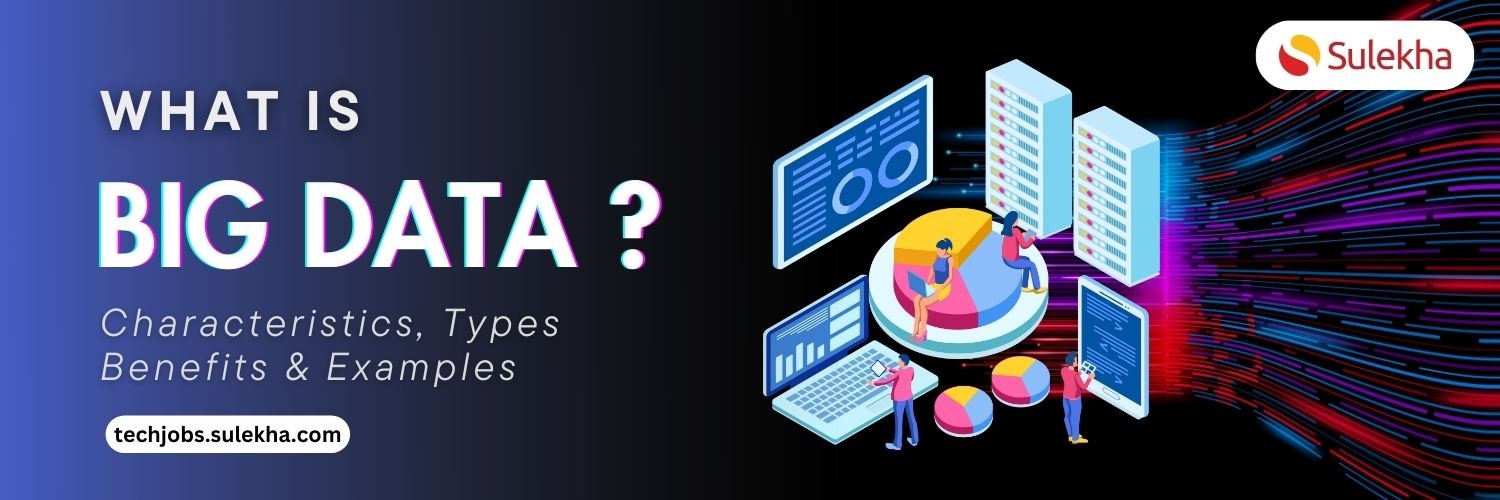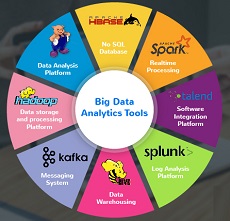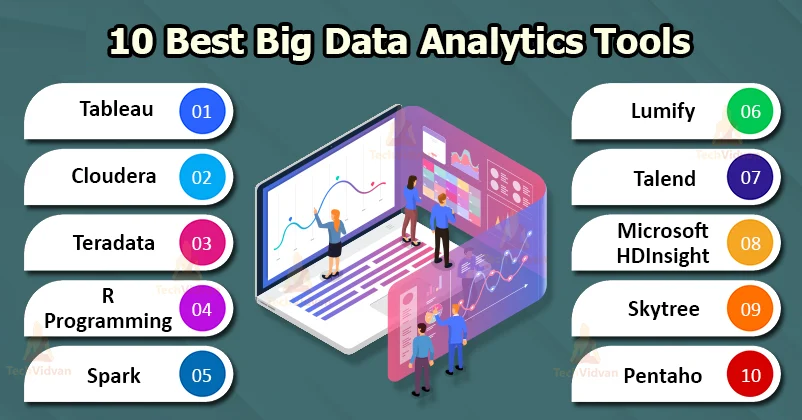What is Big Data – Characteristics, Types, Benefits & Examples

Big data, a significant and rapidly growing field in current technology, is poised to reshape industries and drive innovation. According to Fortune Business Insights, the global big data technology market size was valued at USD 349.40 billion in 2023 and is projected to grow from USD 397.27 billion in 2024 to USD 1,194.35 billion by 2032, exhibiting a CAGR of 14.8% during the forecast (2024-2032).
The factors driving this exponential growth include the increasing volumes of data generated, advancements in technology like IoT, and continuous innovation in software development services. However, the real game-changer is the role of big data in providing businesses with crucial insights, aiding in decision-making, and, ultimately, securing a competitive advantage. The rise of big data technologies like generative AI, advanced analytics, and machine learning is revolutionizing data analysis and processing, enabling organizations to extract valuable insights from large and diverse datasets efficiently.
In this blog, we shall discuss What is Big data, advantages of Big Data, Characteristics of Big Data, Types of Big Data and 5 Applications of big data.
What is Big data?
In a simple way of explanation, big data is large, extensive, and complex data sets derived from diverse, new, and old data sources. The traditional processing method cannot manage this enormous amount of data. However, by gaining helpful insight from these massive amounts of data, we can address organizational problems with ease.
According to Gartner: "Big data" is high-volume, -velocity and -variety information assets that demand cost-effective, innovative forms of information processing for enhanced insight and decision making.
Types of Big Data
Structured
Structured data in the context of Big Data refers to well-organized and formatted data that follows conventional rules and is typically stored in databases, datasets, and spreadsheets. It is characterized by its tabular structure, where data is stored in rows and columns, making it easily accessible and usable by humans and machines.
Example:
An example of structured data in Big Data is stored in a relational database, where each record contains specific fields like customer names, addresses, phone numbers, and email addresses.
This structured format allows for efficient data querying, analysis, and manipulation, making it ideal for business intelligence, analytics, and machine learning applications.
Unstructured data
Unstructured data is a massive part of big data and refers to information that doesn't have a predefined format or organization. It's like a giant warehouse filled with all sorts of items, not neatly organized on shelves. Unlike structured data that fits into a spreadsheet's rows and columns, unstructured data can be messy and complex. Here are some examples:
· Text documents
· Images and videos
· Sensor data
· Audio recordings
· Social media data
While unstructured data can be challenging, it also holds immense potential. We can extract valuable insights from this vast and diverse information source using techniques like natural language processing (NLP) and computer vision. This can help businesses understand customer sentiment, improve product development, optimize operations, and gain a competitive edge.
Semi-structured data
Semi-structured data is a form that does not adhere to the tabular structure typical of relational databases. It contains tags or markers to separate semantic elements and enforce hierarchies of records and fields, making it self-describing. Semi-structured data allows entities of the same class to have different attributes, even when grouped; the order of attributes is not crucial. This data type is commonly used in various applications, especially with the rise of the Internet, where different sources need a medium for exchanging information. Examples of semi-structured data formats include XML, JSON, HTML, log files, and emails.
Examples of Semi-structured Data in Big Data
· Emails
· Log Files
· Social Media Posts
· Web Pages
Characteristics of Big Data
Big data is a term used to describe a massive amount of data that cannot be stored, processed, or analyzed using traditional tools. Four main Vs characterize it:
1. Volume: Big data refers to the vast amount of data generated from various sources, including social media platforms, networks, and machines. This data is measured in terabytes, petabytes, and exabytes.
2. Velocity: Big data is generated rapidly, making it challenging to process and analyze in real time. For example, Google receives 3.5 billion searches daily, and Facebook users increase by 22% yearly.
3. Variety: Big data comes from various sources, including structured, semi-structured, and unstructured data. Structured data is organized, semi-structured data is partially organized, and unstructured data is not organized.
4. Veracity: Big data may contain inconsistencies and uncertainties, making it challenging to analyze accurately. It is essential to ensure the quality and accuracy of the data to extract valuable insights.
In addition to these four Vs, some sources also mention the following Vs:
1. Value: Big data must provide value to the organization by generating insights that can be used to make informed decisions.
2. Variability: Big data may change in structure and meaning over time, making it challenging to analyze consistently.
Big data analytics is extracting valuable insights from big data using various techniques, including machine learning, artificial intelligence, and data mining. It is used in multiple industries, including healthcare, finance, marketing, and government, to improve decision-making, optimize operations, and enhance customer experiences.
Advantages of Big Data features
Big Data's predictive analysis capability stands out as a significant advantage. By leveraging Big Data analytics tools, businesses and organizations can forecast outcomes precisely, empowering them to enhance decision-making, optimize operational efficiencies, and effectively mitigate risks. The Big Data analytics tools are:
1. Airflow
2. Delta Lake
3. Drill
4. Druid
5. Flink
6. Hadoop
7. Hive.
Businesses globally are optimizing their digital marketing strategies and enhancing consumer experiences by leveraging social media data through Big Data analytics tools. This enables companies to gain valuable insights into customer pain points and refine their offerings to improve products and services.
Big Data takes all the important info from different places and gives you useful insights. Like, around 43% of companies struggle 'because they don't have the right tools to sift through all the junk data. It ends up costing them loads to dig out the good stuff. Big Data tools can fix this mess, saving you time and cash.
Big Data analytics can help companies snag more sales leads, leading to a bump in revenue. Businesses are diving into Big Data tools to determine how their products/services are performing and how customers react. This way, they can figure out where to focus their time and money.
Big Data insights help you stay ahead of the game. You can scope out the market to see what promos and deals your competitors are dishing out, then one-up them with better offers for your customers. Plus, Big Data insights let you study customer behavior, catch onto trends, and give customers a super personalized experience.
Who is using Big Data? 5 Applications
Healthcare
In healthcare, big data is used to predict hospital admissions, detect diseases early, personalize treatment, improve clinical care, enhance diagnosis, and accelerate clinical research.
It enables healthcare professionals to analyze vast amounts of data to identify patient trends, predict outcomes, and suggest preventive measures. By leveraging big data analytics, healthcare providers can optimize patient care, reduce costs, and improve healthcare quality and efficiency.
2. Academia
In academia, big data improves student outcomes, enhances operational efficiency, and advances research. For instance, AI-enabled technologies identify and detect fake news, quantify and validate gender stereotypes and sexist language, fight plagiarism, and identify inaccurate results and statistics. Big data analytics is also used to analyze large volumes of data from various sources to determine patient trends, predict outcomes, and suggest preventive measures in healthcare.
In education, big data is used to understand students' educational experiences, improve teaching methods, and develop personalized learning plans based on their strengths, weaknesses, and learning styles. By analyzing student data, universities can predict student behavior, improve student outcomes, and reduce dropout rates. Big data analytics can also help educational institutions save time and streamline different processes by generating insightful information from a large volume of data and providing accurate insights about students' performance from day one.
3. Banking
Big data is used in banking to analyze large volumes of data to detect patterns, trends, and anomalies for risk management, fraud detection, and customer insights. Banks can make more informed decisions, improve customer service, and personalize offerings by processing vast amounts of structured and unstructured data. Predictive analytics and machine learning algorithms are employed to forecast market trends, identify potential risks, and optimize operational efficiency. Real-time monitoring of transactions and customer behavior helps prevent fraudulent activities and enhance security measures.
4. Manufacturing
Big data is used in manufacturing to optimize production processes, improve product quality, reduce costs, and drive innovation. Manufacturers can collect and analyze large amounts of data from machines, processes, and supply chains to gain real-time insights that help identify inefficiencies, reduce waste, and optimize operations. Big data analytics can also help manufacturers predict maintenance needs, prevent downtime, and create a safer work environment.
Additionally, big data analytics can improve supply chain management for manufacturers by analyzing vast amounts of data on suppliers, inventory, and logistics to optimize supply chain operations, reduce costs, and improve efficiency.
5. IT
Information Technology (IT) leverages Big Data to extract valuable insights and drive strategic decision-making. IT professionals utilize advanced tools and technologies to store, manage, analyze, and visualize large volumes of data efficiently. By applying predictive analytics, IT can forecast trends and customer behavior, proactively enabling organizations to respond to market dynamics.
Furthermore, IT harnesses Big Data for personalization, tailoring customer experiences and services based on data-driven insights. Through machine learning and artificial intelligence, IT develops innovative solutions that automate processes, enhance productivity, and deliver personalized experiences. Overall, IT's utilization of Big Data empowers organizations to optimize operations, improve customer satisfaction, and stay competitive in the rapidly evolving digital landscape.
In conclusion, big data represents a transformative force in the modern era, offering organizations unprecedented opportunities to harness vast amounts of data for insights, innovation, and competitive advantage. By leveraging the characteristics of volume, velocity, variety, and veracity, businesses can unlock the value of big data to make informed decisions, enhance operational efficiency, understand customers better, and drive innovation. With the right tools, technologies, and strategies, organizations can navigate the complexities of big data and capitalize on its potential to thrive in today's dynamic and data-driven landscape.
Find a course provider to learn Big Data
Java training | J2EE training | J2EE Jboss training | Apache JMeter trainingTake the next step towards your professional goals in Big Data
Don't hesitate to talk with our course advisor right now
Receive a call
Contact NowMake a call
+1-732-338-7323Take our FREE Skill Assessment Test to discover your strengths and earn a certificate upon completion.
Enroll for the next batch
big data full course
- Dec 10 2025
- Online
big data full course
- Dec 11 2025
- Online
big data full course
- Dec 12 2025
- Online
Related blogs on Big Data to learn more

Top 10 Open-Source Big Data Tools in 2024
In the dynamic world of big data, open-source tools are pivotal in empowering organizations to harness the immense potential of vast and complex datasets. Moreover, as we enter 2024, the landscape big data tools and technologies continues evolving be

AWS Big Data Certification Dumps Questions to Practice Exam Preparation
Certification in Amazon Web Service Certified Big data specialist will endorse your skills in the design and implementation of the AWS services on the data set. These aws big data exam questions are prepared as study guide to test your knowledge and

Top 25 Big Data Questions and Answers for Certification Passing score
You can appear for big data certification exam with confidence and come out with certification. We have prepared a bunch of important big data exam questions along with the correct answer and the explanation for the right answer. Utilize these sample

Sixth Edition of Big Data Day LA 2018 - Register Now!
If you’re keen tapping into the advances in the data world, and currently on a quest in search engines, looking for Big Data conferences and events in the USA, there is a big one coming up your way! Yes, the sixth annual edition of Big Data Day LA

15 Popular Big Data Courses to learn for the future career
We have found a list of big data courses that are necessarily required for the future. Professionals and freshmen who are learning these courses prepare the participants to see bigdata careers with high pay jobs.

Best countries to work for Big Data enthusiasts
China is fast becoming a global leader in the world of Big Data, and the recently held China International Big Data Industry Expo 2018

Top Institutes to enroll for Big Data Certification Courses in NYC
If achieving a career breakthrough is hard, harder is sustaining a long-run. Why? Organizations are focusing on New Yorkers who can work dynamically and leverage their skills from the word go, and that’s why.

The emergence of Cloudera
Cloudera is the leading worldwide platform provider of Machine Learning. There is reportedly an accelerated momentum in the Cybersecurity market.

Why there is a need to fill the skill gap to land in a Hadoop and Big Data career?
The world is witnessing the tremendous learning of Big Data platform and artificial intelligence associated with it. The demand for Analytics skill is going up steadily but there is a huge deficit on the supply side.
Latest blogs on technology to explore

From Student to AI Pro: What Does Prompt Engineering Entail and How Do You Start?
Explore the growing field of prompt engineering, a vital skill for AI enthusiasts. Learn how to craft optimized prompts for tools like ChatGPT and Gemini, and discover the career opportunities and skills needed to succeed in this fast-evolving indust

How Security Classification Guides Strengthen Data Protection in Modern Cybersecurity
A Security Classification Guide (SCG) defines data protection standards, ensuring sensitive information is handled securely across all levels. By outlining confidentiality, access controls, and declassification procedures, SCGs strengthen cybersecuri

Artificial Intelligence – A Growing Field of Study for Modern Learners
Artificial Intelligence is becoming a top study choice due to high job demand and future scope. This blog explains key subjects, career opportunities, and a simple AI study roadmap to help beginners start learning and build a strong career in the AI

Java in 2026: Why This ‘Old’ Language Is Still Your Golden Ticket to a Tech Career (And Where to Learn It!
Think Java is old news? Think again! 90% of Fortune 500 companies (yes, including Google, Amazon, and Netflix) run on Java (Oracle, 2025). From Android apps to banking systems, Java is the backbone of tech—and Sulekha IT Services is your fast track t

From Student to AI Pro: What Does Prompt Engineering Entail and How Do You Start?
Learn what prompt engineering is, why it matters, and how students and professionals can start mastering AI tools like ChatGPT, Gemini, and Copilot.

Cyber Security in 2025: The Golden Ticket to a Future-Proof Career
Cyber security jobs are growing 35% faster than any other tech field (U.S. Bureau of Labor Statistics, 2024)—and the average salary is $100,000+ per year! In a world where data breaches cost businesses $4.45 million on average (IBM, 2024), cyber secu

SAP SD in 2025: Your Ticket to a High-Flying IT Career
In the fast-paced world of IT and enterprise software, SAP SD (Sales and Distribution) is the secret sauce that keeps businesses running smoothly. Whether it’s managing customer orders, pricing, shipping, or billing, SAP SD is the backbone of sales o

SAP FICO in 2025: Salary, Jobs & How to Get Certified
AP FICO professionals earn $90,000–$130,000/year in the USA and Canada—and demand is skyrocketing! If you’re eyeing a future-proof IT career, SAP FICO (Financial Accounting & Controlling) is your golden ticket. But where do you start? Sulekha IT Serv

Train Like an AI Engineer: The Smartest Career Move You’ll Make This Year!
Why AI Engineering Is the Hottest Skillset Right Now From self-driving cars to chatbots that sound eerily human, Artificial Intelligence is no longer science fiction — it’s the backbone of modern tech. And guess what? Companies across the USA and Can

Confidence Intervals & Hypothesis Tests: The Data Science Path to Generalization
Learn how confidence intervals and hypothesis tests turn sample data into reliable population insights in data science. Understand CLT, p-values, and significance to generalize results, quantify uncertainty, and make evidence-based decisions.
